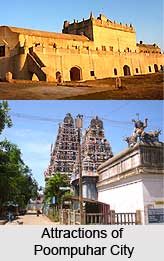 Poompuhar was the chief port of the Chola kingdom during the Sangam Age in the Tamil Nadu state of India. It was earlier known as Kaviripoompattinam. The ancient glory of the Tamils can be visualised by seeing this port town. Sangam literature and the two great epics Silappadhikaram and Manimekalai informs about its glory. It was an international seaport and many languages were spoken by the merchants of various countries.
Poompuhar was the chief port of the Chola kingdom during the Sangam Age in the Tamil Nadu state of India. It was earlier known as Kaviripoompattinam. The ancient glory of the Tamils can be visualised by seeing this port town. Sangam literature and the two great epics Silappadhikaram and Manimekalai informs about its glory. It was an international seaport and many languages were spoken by the merchants of various countries.
The Poompuhar city had separate quarters for foreigners. Both day and night bazaars called Nalangadi and Allangadi used to remain busy in selling a plethora of articles like spices, gold, fancy wear, garments, liquor, pearls and precious stones and various edibles. Now-a-days, the big town has reduced to a small village. But the evidences of its past glory in and around Poompuhar can be seen yet.
History of Poompuhar
The travelogues of Periplus and Merris Erithroly, Ptolemy and Pliny describes about antiquity of this port. The reference of this ancient town can be seen in the Pali literature like Milindapanha, Buddha Jataka tales, Abithama Avathar and Buddha Vamsakatha. About 2000 years ago, Buddhism flourished here. The evidences of it were found out of the donation of a pillar by a Buddhist Somaya Bikkuni of Poompuhar during the second century B.C. The Brahmi inscriptions of 2nd century B.C. also have the mention of the city.
The inscription at Sayavanam temple in Poompuhar also tells about its history. The Chola kings of the Sangam Age ruled the city with pride and decorated it in various ways. The mention of a great festival called Indra Vizha devoted to Lord Indra is found in most of them. Evidences have been found of its persistence till the later Chola period.
Plan of Poompuhar City
The plan of Poompuhar city is derived from various literary evidences. The city was divided into two well marked divisions as Pattinappakkam and Maruvurpakkam. The marketplace of Poompuhar was sandwiched in between Nalangadi, the day market, and Allangadi, the night bazaar.
The seashore was occupied by ferocious undaunting fisher folks. The warehouses were also located there. Artisans, merchants, sweet-vendors, butchers, potters and diamond-cutters lived in Maruvurpakkam.
Kings, nobles, elite citizens, rich traders and farmers, physicians, astrologers, the king`s barracks and court dancers lived in Pattinappakkam.
Vellidai Murugan, Elanchi Mandram, Nedunkal Mandram, Bootha Chatukkam and Pavai Mandram were located in Pattinappakkam.
The city also had well laid-out gardens like Elavanthigai Cholai, Uyya Vanam, Champapathi Vanam and Kaveri Vanam. Temples for Lord Siva, Chathukka Bootham, Indra, Balarama, Soory (Sun), Machathan, Chandra (Moon), Arugan (Jain) and Thirumal (Vishnu) were there besides Buddha stupas and seven Buddha vihars, Champapathi Amman temple, brick idols and Ulagu Arivai Mandram.
There were avenues and separate sacred passages for temple idols to take bath in the river. There were ring wells on the fringes of the city. There was a separate quarter for foreigners besides separate marketplaces.
All along the river banks, cool and shady trees were planted. This in short is the plan of Kaviripoompattinam or Poompuhar. `Puhar` means estuary and the city was situated at the estuary of the only perennial river of Cauvery.






































